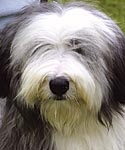|
WHAT IS A BEARDIE?
The Bearded Collie is a Scottish herding dog with a long, shaggy coat and an exuberant, intelligent personality. Nowadays the majority of Bearded Collies are pets or show dogs, but they are also still used for herding on farms in Britain, as their style of working is particularly suited to cattle and hill sheep.
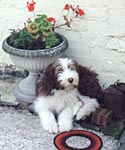 Beardies can be found in a wide selection of coat lengths and colour shades, with white collie markings which also vary considerably. The result of this is that Beardies tend to be very individual in appearance, no two looking exactly the same. The two basic colours are black and brown, with their accompanying dilutes ( blue and fawn ) making four possible birth colours. These colours go through a paling phase from late puppy hood to early adulthood before the final darker adult coat comes through. In the case of browns in particular it can be very difficult to predict the final adult colour, although the ears give a good indication, as they do not pale along with the rest of the coat. Beardies can be found in a wide selection of coat lengths and colour shades, with white collie markings which also vary considerably. The result of this is that Beardies tend to be very individual in appearance, no two looking exactly the same. The two basic colours are black and brown, with their accompanying dilutes ( blue and fawn ) making four possible birth colours. These colours go through a paling phase from late puppy hood to early adulthood before the final darker adult coat comes through. In the case of browns in particular it can be very difficult to predict the final adult colour, although the ears give a good indication, as they do not pale along with the rest of the coat.
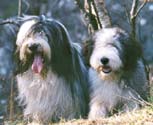 The dog underneath the coat has a very well-constructed and natural body shape, longer than it is high, with deep, long ribs and good angulation creating a real athlete, well able to go for miles over the hills or participate in agility, whatever may be required.The coat should be fairly harsh, with plenty of undercoat. The skull is broad and flat. One of the most attractive features of the Beardie is the wise, kindly expression. The dog underneath the coat has a very well-constructed and natural body shape, longer than it is high, with deep, long ribs and good angulation creating a real athlete, well able to go for miles over the hills or participate in agility, whatever may be required.The coat should be fairly harsh, with plenty of undercoat. The skull is broad and flat. One of the most attractive features of the Beardie is the wise, kindly expression.
 Temperamentally, Beardies are most appealing to those who like an intelligent, responsive and energetic dog. They like human company, and can become difficult and destructive if left alone all day, as they like to have things to do. Generally they like children very much and love to play, but one should remember that they are herding dogs that will chase and nip when excited, so play with young children should always be supervised..Barking is an important part of this breed's working style with stock,so they will tend to express extremes of emotion this way. Beardies usually live peacefully with other breeds and species, although first introductions may be fairly lively if their herding instincts are aroused! Temperamentally, Beardies are most appealing to those who like an intelligent, responsive and energetic dog. They like human company, and can become difficult and destructive if left alone all day, as they like to have things to do. Generally they like children very much and love to play, but one should remember that they are herding dogs that will chase and nip when excited, so play with young children should always be supervised..Barking is an important part of this breed's working style with stock,so they will tend to express extremes of emotion this way. Beardies usually live peacefully with other breeds and species, although first introductions may be fairly lively if their herding instincts are aroused!
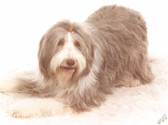 They are very trainable and obliging when handled correctly, but do not respond well to harsh or confused training regimes, being sensitive to human mood and behaviour. Firm, confident and kindly, reward-based training with clear communication will produce a very engaging and amenable companion. Most Beardies love Agility, Obedience and herding and are always glad of a chance to work in partnership with their humans. Their boisterous, optimistic attitude and tendency to go for "lateral thinking" ensure that they will always be rewarding and interesting - if not entirely predictable! - to work with. A sense of humour is a necessary attribute for a Beardie owner. They are very trainable and obliging when handled correctly, but do not respond well to harsh or confused training regimes, being sensitive to human mood and behaviour. Firm, confident and kindly, reward-based training with clear communication will produce a very engaging and amenable companion. Most Beardies love Agility, Obedience and herding and are always glad of a chance to work in partnership with their humans. Their boisterous, optimistic attitude and tendency to go for "lateral thinking" ensure that they will always be rewarding and interesting - if not entirely predictable! - to work with. A sense of humour is a necessary attribute for a Beardie owner.
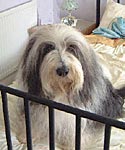 This is a fairly healthy breed. There are problems with hip dysplasia and autoimmune disorders, but these are of relatively low incidence compared with a large number of other breeds. The shaggy coat can create skin problems if not groomed regularly or if not dried off in wet weather, especially on the feet. Average life expectancy is about 14 years This is a fairly healthy breed. There are problems with hip dysplasia and autoimmune disorders, but these are of relatively low incidence compared with a large number of other breeds. The shaggy coat can create skin problems if not groomed regularly or if not dried off in wet weather, especially on the feet. Average life expectancy is about 14 years
Sue Nicholls-Ward  is the commitee member looking after this web page. Please contact her with any queries or comments you may have. is the commitee member looking after this web page. Please contact her with any queries or comments you may have.
|
Colours in the Bearded Collie
To the inexperienced eye Beardies appear in a multitude of shades and patterns of various colours but with very little practise it is easy to recognise the different types.
Basic Colours
These are Black,Blue, Brown and Fawn. Each colour will also have white in places on the body to a greater or lesser degree.
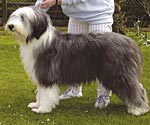
An 10-month old slate Dog
These colours are easily identified at birth in the vast majority of Beardie Litters.
Paleing
ALL Beardie puppies are born with full, rich body hair colouring but as they get older, from around 4 or 5 weeks in many cases they can begin to develop paler rings of hairs around the eyes and these are indicative of a beardie trait which gives rise to a multitude of colouring during the life of an individual Beardie.This is just the beginning and in these individuals the paleing spreads over the whole body coat during the early (12-18 months) life of the dog in dogs which show this. Some beardies retain their original colour during all their life and do not pale at all!
Not all beardies undergo this phase and it is very variable in its expression. Some dogs will pale to almost white at the age of around 15-18 months before the new coat starts to grow , usually most prominently over the shoulders. This can lead to dogs with a pale body, dark ears (which tend to stay darker than the overall body colour) and a saddle of newer sub-adult (junior) coat .
About 12 months later the dog will be dark-grey all over, somewhere approaching the colour of the ears. The areas of the dog which were white at birth do not change colour and although when the rest of the body coat pales they may become more indistinct they again become prominent as the dog gains its adult coat colour. This will be very evident in the case of a dark adult Dog but not as obvious in a pale fawn or a silvery Blue. In Browns this trait can lead to almost a different appearance of dog each year, since to a lesser extent many beardies pale and darken with each year.
|
